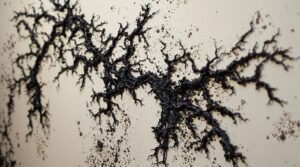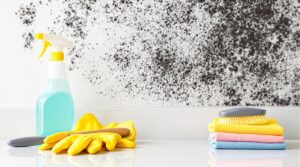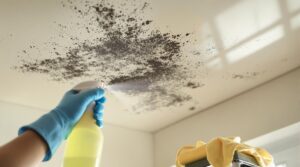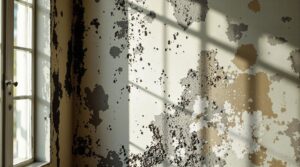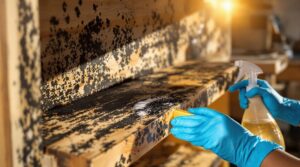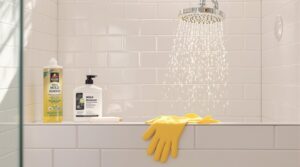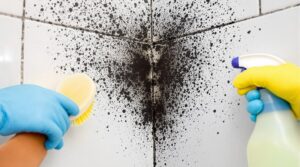Dealing with black mold from water damage requires prompt attention and proper remediation techniques to prevent extensive damage and mitigate significant health risks. Black mold thrives in damp environments, reproducing by releasing spores that can trigger severe reactions in individuals with compromised immune systems. Exposure poses health risks, including respiratory problems and allergic reactions. To address black mold, it is essential to understand the signs of growth, health risks, and preventative measures, as well as the importance of seeking professional help when necessary, to guarantee effective remediation and minimize harm.
Key Takeaways
- Identify and remediate black mold promptly, ideally within 24-48 hours of water damage, to prevent extensive damage and health risks.
- Wear personal protective gear, including N95 respirator, gloves, and safety goggles, during mold cleanup to minimize exposure.
- Remove saturated materials, use fans and dehumidifiers, and clean hard surfaces with a 10% bleach solution to remediate mold.
- Consider hiring a professional for areas exceeding 10 square feet of mold, hidden mold, or contaminated water damage.
- Document damage and remediation efforts thoroughly to support insurance claims, and consider engaging a public adjuster for expert guidance.
Understanding Mold and Mildew Growth
Because mold and mildew growth can have severe consequences on both the structural integrity of a building and the health of its occupants, understanding the conditions that facilitate their development is vital.
Mold and mildew are fungi that thrive in damp environments, often resulting from water damage. They reproduce by releasing spores into the air, which can form new colonies. The ideal conditions for mold growth occur within 24-48 hours after water damage, emphasizing the need for swift action to mitigate the issue.
Common types of mold include Aspergillus, Cladosporium, and Stachybotrys Chartarum, also known as black mold, which can pose significant health risks.
Mold growth is often the result of water damage, and its development can be rapid. Understanding the causes of mold and mildew growth is essential for preventing their proliferation and mitigating the potential health risks associated with exposure to these microorganisms.
Maintaining indoor humidity below 50% through proper ventilation and dehumidification is crucial for preventing mold growth in vulnerable areas.
Signs of Mold and Mildew After Water Damage
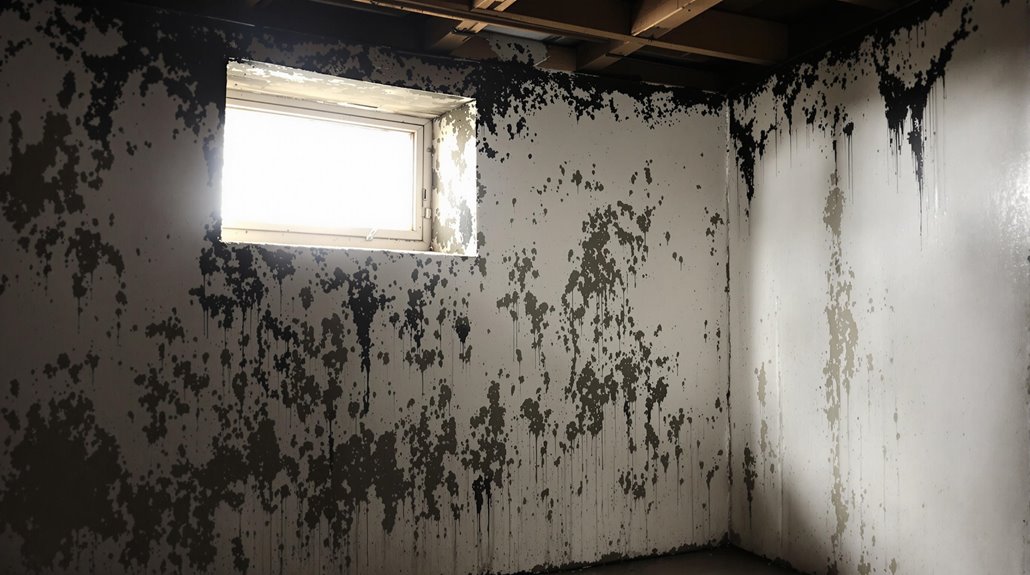
The aftermath of water damage presents an ideal environment for mold and mildew growth, and recognizing the signs of infestation is vital for timely remediation.
Visible discoloration on surfaces, such as greenish-black patches, and a persistent musty odor in the affected areas are common signs of mold and mildew after water damage. These indicators can appear within 24 to 48 hours of water exposure, emphasizing the importance of early detection.
In cases where mold growth is suspected but not visible, professional mold testing is recommended, particularly for hazardous types like black mold. DIY kits may not provide thorough results, especially in hidden areas.
Prompt identification and remediation of mold and mildew infestations are essential to prevent extensive damage and mitigate the impact on a home's value and aesthetic appeal.
Recognizing the signs of mold and mildew after water damage is a significant step in addressing the issue effectively.
People with compromised immune systems face heightened health risks when exposed to mold, including respiratory issues and organ damage.
Health Risks Associated With Mold Exposure
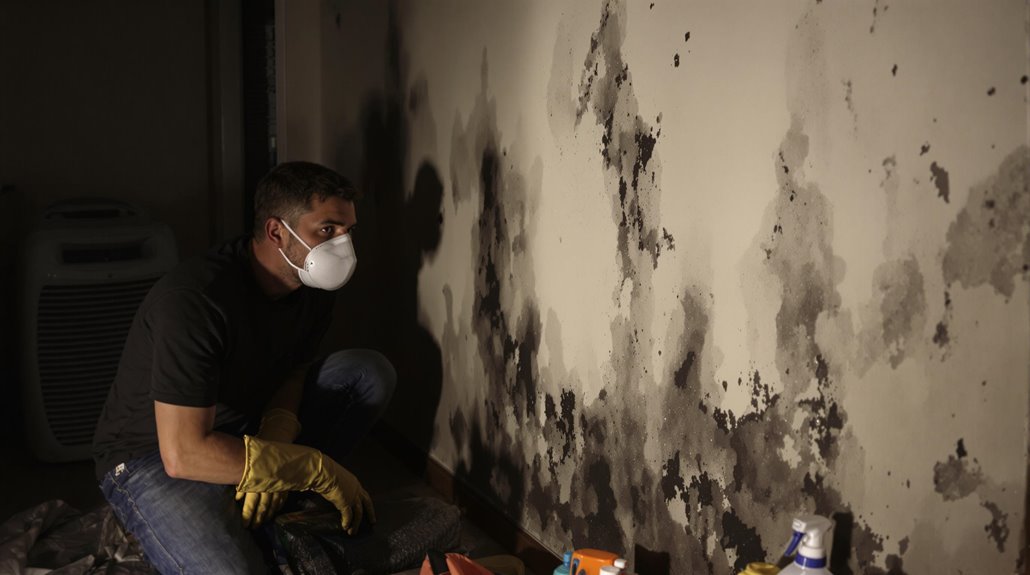
Exposure to mold, particularly black mold, poses significant health risks, including respiratory problems, allergic reactions, and chronic fatigue. Sensitive individuals such as children and those with preexisting conditions are disproportionately affected.
The inhalation of mold spores can trigger a range of symptoms, from mild discomfort to severe reactions, especially in individuals with compromised immune systems or asthma.
Understanding the health issues associated with mold exposure is essential for mitigating its effects and reducing the risk of mold-related illnesses.
Those exposed to mycotoxins in mold often experience cognitive dysfunction, including brain fog, memory problems, and difficulty concentrating.
Mold Exposure Health Issues
When individuals come into contact with mold, they may experience a range of health issues, with sensitive individuals being particularly prone to respiratory problems. Prolonged exposure to mold, especially black mold (Stachybotrys chartarum), can result in serious health complications.
The following health issues are associated with mold exposure:
- Respiratory problems: Mold exposure can trigger asthma attacks, chronic cough, and throat irritation in sensitive individuals.
- Neurological issues: Prolonged exposure to mold can lead to neurological problems, especially in immunocompromised individuals.
- Allergic reactions: Symptoms of mold exposure may manifest within hours of contact and can include sneezing, runny or stuffy nose, skin rashes, and eye irritation.
Individuals with pre-existing health conditions are particularly vulnerable to severe reactions, emphasizing the importance of minimizing exposure to mold.
Studies show that exposure to black mold spores has been linked to 96% of chronic sinus infections.
Common Mold Related Illnesses
Mold exposure poses significant health risks, and certain individuals are more susceptible to severe reactions.
Common mold related illnesses include allergic reactions, such as sneezing, runny or stuffy nose, and skin rashes, which affect sensitive individuals and those with pre-existing conditions.
Prolonged exposure to mold, particularly Stachybotrys Chartarum, can lead to severe respiratory problems, including chronic coughing and asthma exacerbation.
Individuals with weakened immune systems, such as pregnant women and people with lung diseases, are at a higher risk of developing serious fungal infections.
Respiratory problems are a major concern, as mold can trigger asthma attacks and worsen existing respiratory conditions.
Immediate remediation after water damage is essential to prevent these health issues.
Chronic exposure can also lead to neurological problems, emphasizing the need for prompt action.
Toxic black mold thrives in environments with humidity levels above 70%, making proper moisture control crucial for prevention.
Reducing Mold Health Risks
Implementing measures to reduce mold health risks is essential for preventing the onset of mold-related illnesses. Mold exposure can trigger allergic reactions, respiratory issues, and exacerbate asthma symptoms, particularly in individuals with weakened immune systems.
The World Health Organization emphasizes the importance of reducing indoor mold levels to improve overall health.
Dark patches with a fuzzy or powdery texture appearing on surfaces within 3-7 days are clear warning signs of black mold growth.
To prevent mold and reduce health risks, consider the following measures:
- Control humidity levels: Maintain a humidity level between 30-50% to prevent moisture buildup, which can lead to mold growth.
- Improve ventilation: Increase air circulation by opening windows, using fans, and installing ventilation systems to reduce stagnation and moisture accumulation.
- Conduct regular inspections: Regularly inspect for signs of mold growth, water leaks, and condensation to prevent mold-related issues.
Preventative Measures to Avoid Mold Growth
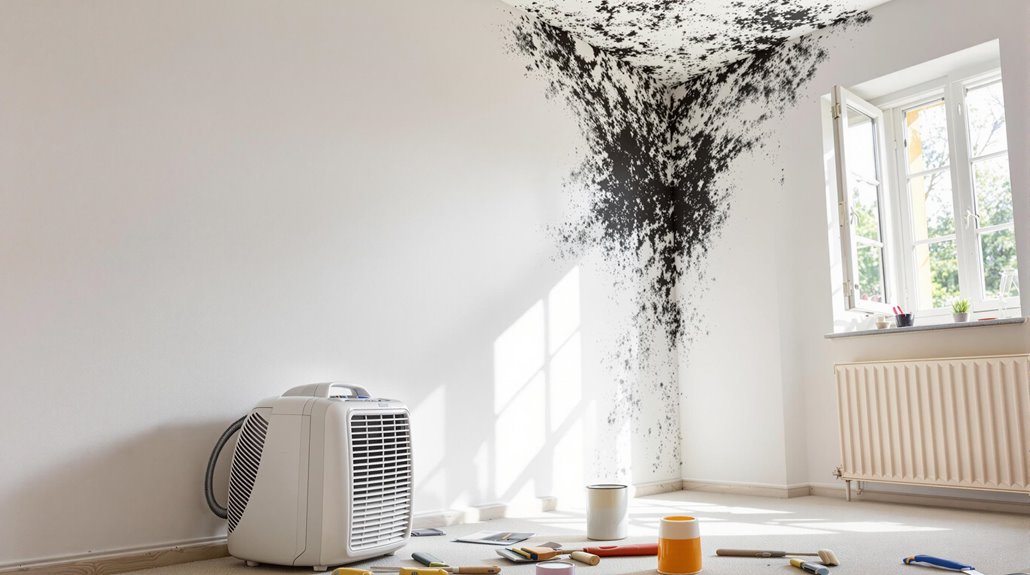
In order to effectively prevent mold growth, it is essential to address water damage promptly, ideally within 24-48 hours of occurrence. This timeframe is vital in preventing mold and mildew from developing. To maintain a mold-free environment, it is important to control humidity levels, guarantee proper ventilation, and utilize mold-resistant materials. The average family produces 4 gallons of moisture daily through normal activities, making proper moisture control crucial.
| Prevention Measures | Description |
|---|---|
| Dehumidify | Use dehumidifiers and fans to maintain low humidity levels, below 60%. |
| Ventilate | Guarantee proper ventilation in high-moisture areas, using exhaust fans and opening windows. |
| Mold-Resistant Materials | Use mold-resistant materials for repairs, such as mold-resistant drywall and paint. |
| Regular Maintenance | Regularly inspect and maintain plumbing and roofing to prevent leaks. |
Steps for Cleaning Up Mold After Water Damage
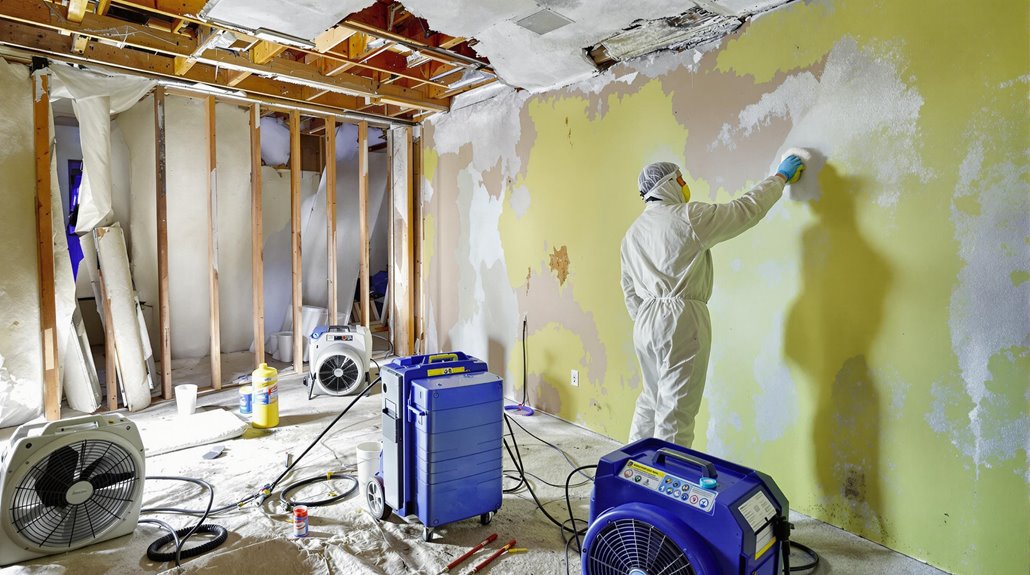
Following the occurrence of water damage, prompt action is essential to prevent black mold growth and mitigate further contamination.
The goal of cleanup is to remove all sources of moisture, dry out the affected area, and eliminate any existing mold.
Key steps in the cleanup process include:
- Removing wet materials: All saturated materials, including drywall, carpets, and furniture, must be removed and discarded to prevent further mold growth.
- Maintaining low humidity: Fans and dehumidifiers should be used to maintain low humidity levels and facilitate faster drying of affected areas.
- Cleaning hard surfaces: A solution of 10% bleach and water should be used to clean hard surfaces, taking care to avoid mixing bleach with ammonia to prevent toxic fumes.
Thorough cleaning and drying of the affected area are vital to preventing mold recurrence and ensuring a safe environment. Effective cleanup prevents mold growth.
Personal Protection During Mold Cleanup
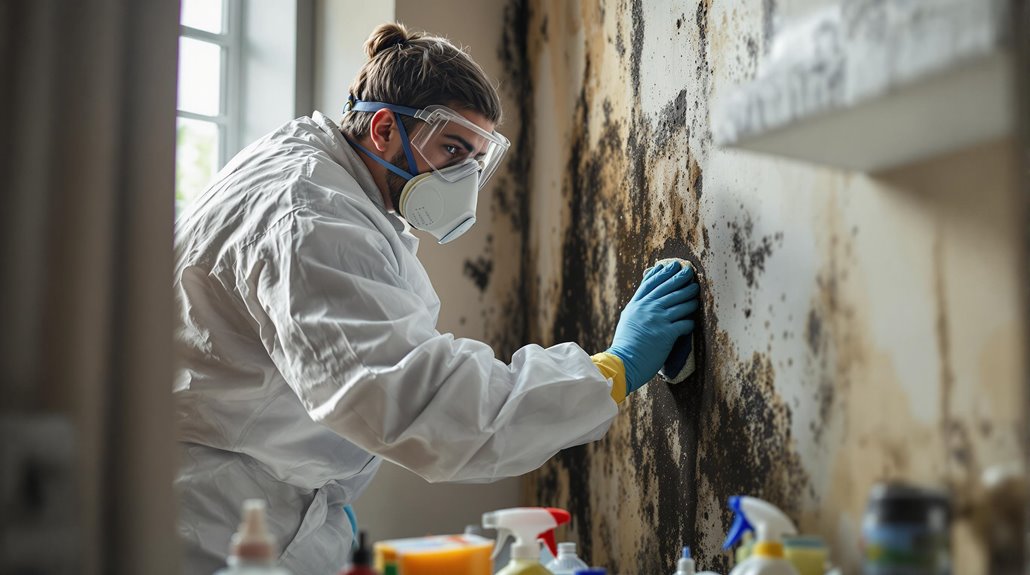
Because black mold poses a significant health risk to individuals involved in the cleanup process, taking precautions to protect oneself from exposure is essential.
Personal protection during mold cleanup is a critical aspect of preventing health issues. To minimize exposure to mold, individuals should wear an N95 respirator or a higher-level mask to filter out mold spores and protect their lungs.
Non-porous gloves, such as those made of rubber or nitrile, should be worn to prevent skin contact with mold and cleaning solutions. Safety goggles are also necessary to shield the eyes from mold spores and cleaning agents.
Additionally, wearing long-sleeved clothing and coverings for the arms and legs can help minimize skin exposure to mold and contaminants.
After completing the cleanup, showering and changing into clean clothes can help prevent the spread of mold spores to other areas of the home, further reducing the risk of exposure to mold.
Effective Mold Removal Techniques and Tools
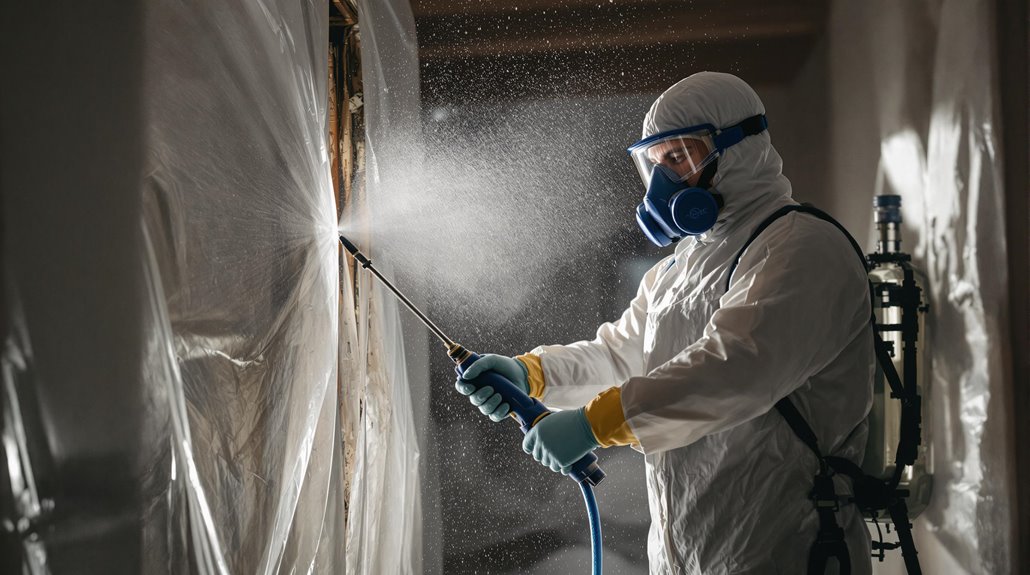
Removing black mold effectively requires a combination of proper techniques and specialized tools. Effective mold removal techniques involve removing affected materials, such as drywall and carpeting, and using misting with water to minimize airborne spores during the cleanup process.
A hydrogen peroxide solution is recommended for killing mold on non-porous surfaces.
The following tools and techniques are essential for effective mold removal:
- Personal Protective Equipment (PPE): Respirators, gloves, and goggles to protect against inhalation and skin exposure to mold spores.
- Misting and Containment Tools: Plastic sheeting to seal off affected areas and prevent the spread of mold spores.
- Cleaning Solutions: A 3% hydrogen peroxide solution for non-porous surfaces and a 10% bleach solution for hard surfaces, used with caution to avoid toxic fumes.
When to Seek Professional Help for Mold Remediation
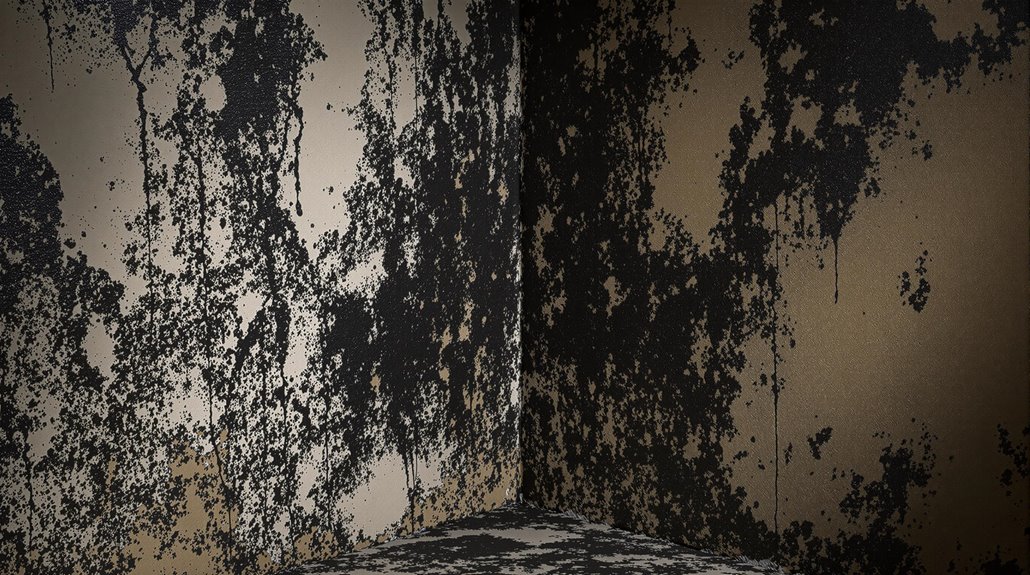
While effective mold removal techniques and tools can be employed for minor infestations, there are situations where professional assistance is warranted. If the affected area exceeds 10 square feet, it is likely that a more serious infestation is present, requiring specialized equipment and techniques for effective mold remediation.
In addition, mold growth in hidden areas, such as behind walls or underneath flooring, necessitates professional intervention to guarantee thorough testing and remediation.
Individuals with compromised health, including those with respiratory issues, allergies, or weakened immune systems, should also consider seeking professional help to minimize health risks associated with mold exposure.
Moreover, if the mold growth results from contaminated water, such as sewage or floodwaters, professional remediation is essential to handle hazardous materials safely.
Uncertainty about the type of mold present, particularly if black mold is suspected, also justifies professional consultation, as specialized removal techniques may be required.
Insurance Coverage and Mold Damage Claims
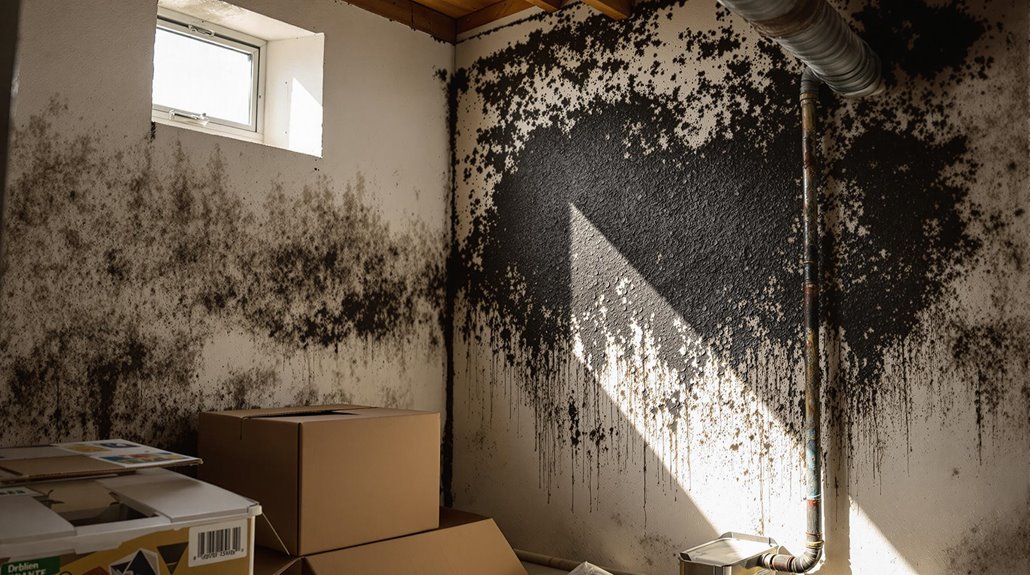
How does homeowners insurance respond to mold damage claims? The response varies depending on the policy and circumstances surrounding the damage. Homeowners insurance may cover mold damage resulting from sudden or accidental water events, but typically excludes damage from long-term leaks or wear and tear.
To navigate the claims process effectively, consider the following key points:
- Policy Limits: Coverage limits for mold remediation can vary greatly, with some policies covering expenses up to $10,000, while others may restrict coverage to as little as $5,000.
- Documentation: Documentation is critical for mold damage claims; homeowners should take photos, keep detailed records of communication with the insurance company, and retain receipts for any related repairs or testing.
- Review Policy Exclusions: Review your specific insurance policy to understand exclusions, coverage limits, and the process for filing a claim related to mold damage.
Preventing Future Mold Growth and Maintenance Tips
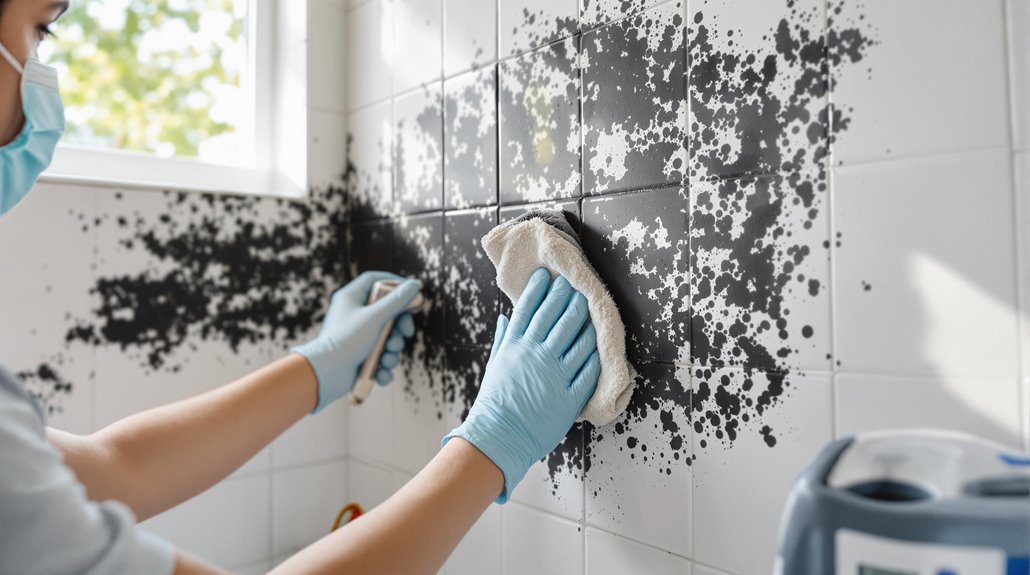
Preventing future mold growth requires a combination of effective mold prevention techniques, regular home maintenance, and effective ventilation methods.
By controlling indoor humidity levels and ensuring adequate air circulation, homeowners can greatly reduce the risk of mold development.
Implementing routine maintenance tasks, such as inspecting plumbing and appliances for leaks and maintaining gutters and downspouts, can also help prevent conditions that foster mold growth.
Mold Prevention Techniques
Implementing effective mold prevention techniques is essential for maintaining a healthy indoor environment and preventing future mold growth.
Mold thrives in damp environments, making humidity control a critical aspect of mold prevention.
Three key mold prevention techniques include:
- Maintaining humidity levels below 60%: Using dehumidifiers and proper ventilation, especially in high-moisture areas like bathrooms and kitchens, can inhibit mold growth.
- Using mold-resistant materials: Incorporating mold-resistant drywall and paint during renovations or repairs creates a protective barrier against mold.
- Ensuring proper drainage: Keeping gutters clean and ensuring proper drainage around the foundation of your home prevents water accumulation that can lead to mold development.
Regular Home Maintenance
While mold prevention techniques can greatly reduce the risk of mold growth, regular home maintenance is essential for identifying and addressing potential issues before they become major problems.
Homeowners should regularly inspect areas prone to moisture, such as bathrooms, kitchens, and basements, and address any leaks or water accumulation immediately to prevent mold growth.
Additionally, maintaining indoor humidity levels below 60% through dehumidifiers and proper ventilation is vital, particularly in high-moisture areas.
Regular cleaning and maintenance of gutters and downspouts can also prevent water damage by ensuring proper water drainage away from the foundation.
Moreover, using mold-resistant materials during renovations and repairs can provide extra protection against mold growth.
Effective Ventilation Methods
In areas where moisture levels are high, effective ventilation methods play an essential role in preventing future mold growth.
This is particularly significant in spaces that have experienced water damage, where clean water sources may have introduced excess moisture.
To prevent mold growth, consider the following methods:
- Exhaust Fans: Install exhaust fans in bathrooms and kitchens to reduce humidity levels by 50% or more during peak usage times.
- Cross-Ventilation: Open windows and doors when weather permits to promote cross-ventilation, helping to lower indoor humidity and prevent mold growth in confined spaces.
- Dehumidifiers: Use dehumidifiers to maintain indoor humidity levels below 60%, as mold thrives in environments with higher moisture levels.
The Benefits Of Consulting A Public Adjuster
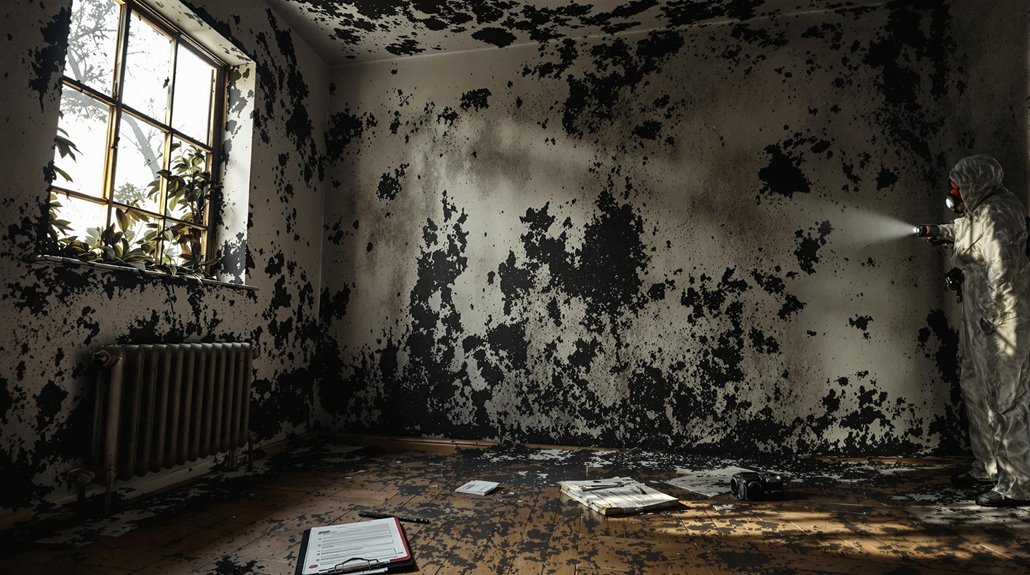
When dealing with black mold damage, consulting a public adjuster can provide policyholders with expertise in insurance claims, ensuring a detailed understanding of their policy and the claims process.
A public adjuster's objective damage assessment helps to accurately determine the extent of the damage, which is vital in preparing a thorough claim.
Expertise In Insurance Claims
Steering through the complexities of insurance claims related to black mold damage can be a challenging task for homeowners, and it is in these situations that consulting a public adjuster is particularly beneficial.
A public adjuster's expertise in insurance claims provides homeowners with an advocate who understands the intricacies of mold-related claims.
Their expertise includes:
- Comprehensive documentation: Taking photographs and writing detailed reports to substantiate claims and facilitate the claims process.
- Effective negotiation: Advocating on behalf of the homeowner with the insurance company to negotiate settlements that reflect the true cost of mold remediation and repairs.
- Policy analysis: Identifying potential coverage for mold damage that homeowners might overlook, ensuring they receive a fair assessment and compensation for their losses.
Objective Damage Assessment
A public adjuster's expertise in insurance claims provides a solid foundation for maneuvering the complexities of mold-related damages.
Their objective damage assessment guarantees that all affected areas are thoroughly documented and evaluated for potential claims. Accurate estimates are vital in determining the extent of damage and the necessary remediation costs.
Additionally, a public adjuster's specialized knowledge of insurance policies enables homeowners to understand their coverage limits and maximize their claims. This is particularly important when dealing with mold damage, as it poses potential health risks if not properly addressed.
Streamlined Claim Process
Engaging the services of a public adjuster can greatly expedite the insurance claim process for homeowners dealing with black mold damage. A public adjuster's expertise in maneuvering through complex insurance policies and regulations can help streamline the claim process.
The benefits of consulting a public adjuster include:
- Accurate documentation and valuation: A public adjuster guarantees that all damages, including those from black mold, are accurately documented and valued according to policy specifics.
- Expert negotiation: A public adjuster can negotiate directly with the insurance company on behalf of the homeowner, reducing the time and stress involved in the claims process.
- Quicker claim resolution: Engaging a public adjuster can lead to a quicker resolution of claims related to black mold, as they are skilled in presenting a compelling case to insurers.
Higher Claim Payouts & Settlements
Frequently, homeowners dealing with black mold damage from water damage find that consulting a public adjuster can greatly increase their insurance claim payout. This is attributed to the public adjuster's expertise in accurately documenting and valuing all related damages.
Their knowledge of complex insurance policies enables them to navigate potential exclusions, leading to higher settlements. On average, homeowners who hire public adjusters can receive settlements that are 20-50% higher than those without professional representation.
By engaging a public adjuster, homeowners can alleviate the stress of the claims process and focus on remediation and recovery while ensuring they receive fair compensation for their losses, resulting in higher claim payouts and settlements.
This expert assistance is invaluable in negotiating with insurance companies.
About The Public Claims Adjusters Network (PCAN)
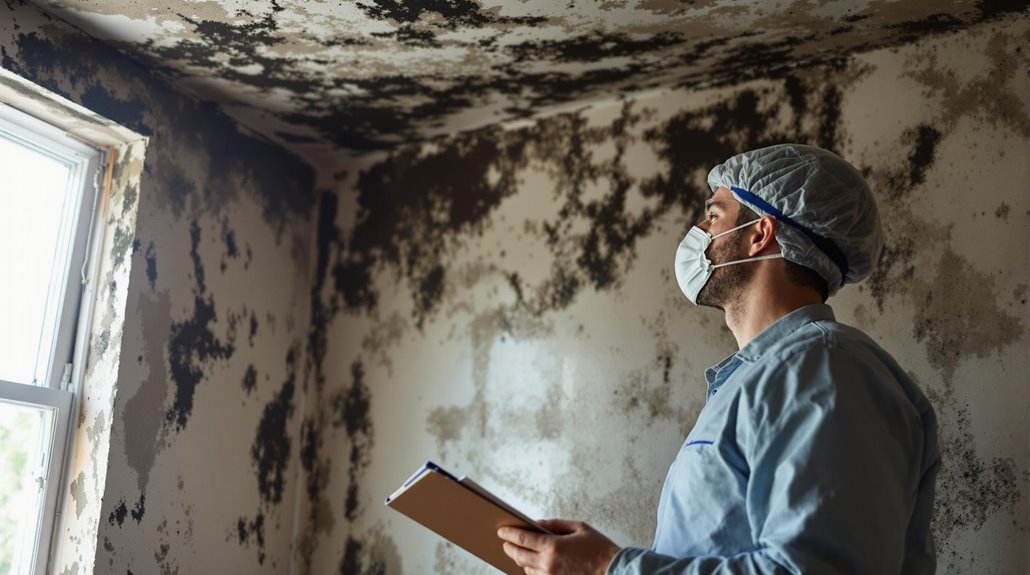
The Public Claims Adjusters Network (PCAN) is a nationwide organization of meticulously vetted public adjusters who possess specialized expertise in managing the complexities of residential and commercial property damage insurance claims.
As a resource for policyholders, PCAN connects individuals with expert public adjusters who are pre-vetted, licensed, and experts in their field.
The following are key aspects of the Public Claims Adjusters Network (PCAN):
- Nationwide presence: PCAN member adjusters are located in over 40 states, providing coverage for a wide range of claim types.
- Stringent vetting process: Public adjusters must undergo an intensive application and interview process to be admitted to the network.
- High standards of ethics and professionalism: Member adjusters are held to the highest standards, with mandatory yearly audits of their licenses and any complaints.
Frequently Asked Questions
How to Get Rid of Black Mold From Water Damage?
Mold remediation involves prompt removal of affected materials within 24-48 hours to prevent further growth and spread of spores. Dampening moldy surfaces, cleaning non-porous surfaces with bleach solution, and disposing of contaminated materials are essential steps.
Is Black Mold From Water Damage Toxic?
Like a silent assassin, black mold from water damage releases its toxic fury, triggering a plethora of mold symptoms, including respiratory problems, skin rashes, and neurological issues, potentially wreaking havoc on human health, especially in vulnerable individuals.
Is It Safe to Stay in a House With Black Mold?
Occupancy in a residence contaminated with black mold poses significant health risks, particularly for individuals with compromised immune systems or pre-existing conditions, and may lead to severe respiratory issues, allergic reactions, and skin irritation.
Can Black Mold Behind Walls Harm You?
Like a silent predator, black mold behind walls can strike unsuspecting occupants, releasing toxic spores that infiltrate indoor air, emphasizing the importance of mold prevention through proper ventilation, insulation, and regular inspections to mitigate health risks.
